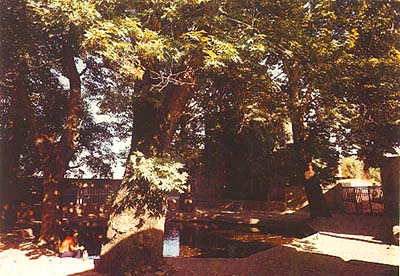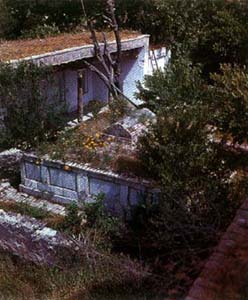To see how Samarkand's 19th - century mosques were decorated,
take a taxi to the ' working Khodja Nisbatdor mosque on Ulitsa Yutuk, which
leads or Ulitsa Suzangaranskaya south of the Registan. The team which restored
the striking patterns in primary colors on the wooden ceiling and mihrab
is now working on the Khazret Khyzr mosque near the bazaar. The resident
holy man seems happy to let non-Muslims inside.
 The
most attractive working Muslim center in Samarkand is in the middle of
a cemetery on the south-eastern edge of the city, reached via Ulitsa Sadreddin
Aim. Khodja Abdi Darun consists of a 12th - century mausoleum, to which
a dome and portico were added In the 15th century, and a 19th - century
mosque and madrasa, all set round a deep and tempting khauz. Spectacular
shade is cast by four giant and very ancient Chinor trees round the pool.
Nearby and largely ruined is the Ishrat Khana mausoleum (1464), which became
the family crypt for minor female Timurids. Its turquoise dome collapsed
in 1903 but the portico survives. The main hall was cross-shaped, leaving
room for spiral staircases in each corner.
The
most attractive working Muslim center in Samarkand is in the middle of
a cemetery on the south-eastern edge of the city, reached via Ulitsa Sadreddin
Aim. Khodja Abdi Darun consists of a 12th - century mausoleum, to which
a dome and portico were added In the 15th century, and a 19th - century
mosque and madrasa, all set round a deep and tempting khauz. Spectacular
shade is cast by four giant and very ancient Chinor trees round the pool.
Nearby and largely ruined is the Ishrat Khana mausoleum (1464), which became
the family crypt for minor female Timurids. Its turquoise dome collapsed
in 1903 but the portico survives. The main hall was cross-shaped, leaving
room for spiral staircases in each corner.


Some maps locate the 17th century Khodja Abdi Birin mausoleum
next to the similarly named Khodja Abdi Darun. (The names refer to the
city walls: birin means without, darun within). In fact it is some distance
away in the Silski rayon (district), reached via the road out to the Kuibyshev
kolhoz (collective farm). Willing and amused old men on a dais outside
will open the mausoleum to show off its plain white Interior. The adjacent
mosque is being restored with local money for local use.
Getting to the Khodja Akrar madrasa is easier and definitely
worthwhile (minibus 31 from the Hotel Samarkand and buses 9 and 20 from
the bazaar). Sheikh Khodja Akrar came to Samarkand from Tashkent in fee
14th century and founded this madrasa, which was rebuilt in 1638 by the
energetic Bukharan dervish Nadir Divanbegi after whom it is also sometimes
named. Restored in 1982, it is, like the madrasas of the Registan, com-pletely
covered in mosaic. Unlike them, its focus is its courtyard. There are modest
iwans on each side rather than one gigantic one, and smaller arches for
each classroom and dor-mitory, all of which are in use. This is Samarkand's
only working madrasa, with 100 students on a four-year course, half of
them boarding. They pay modest fees to the mullah which are topped up by
the state. In the corner to the right of the entrance there are pho-tographs
of the restoration. You may have to pay to look at them.
[back]
